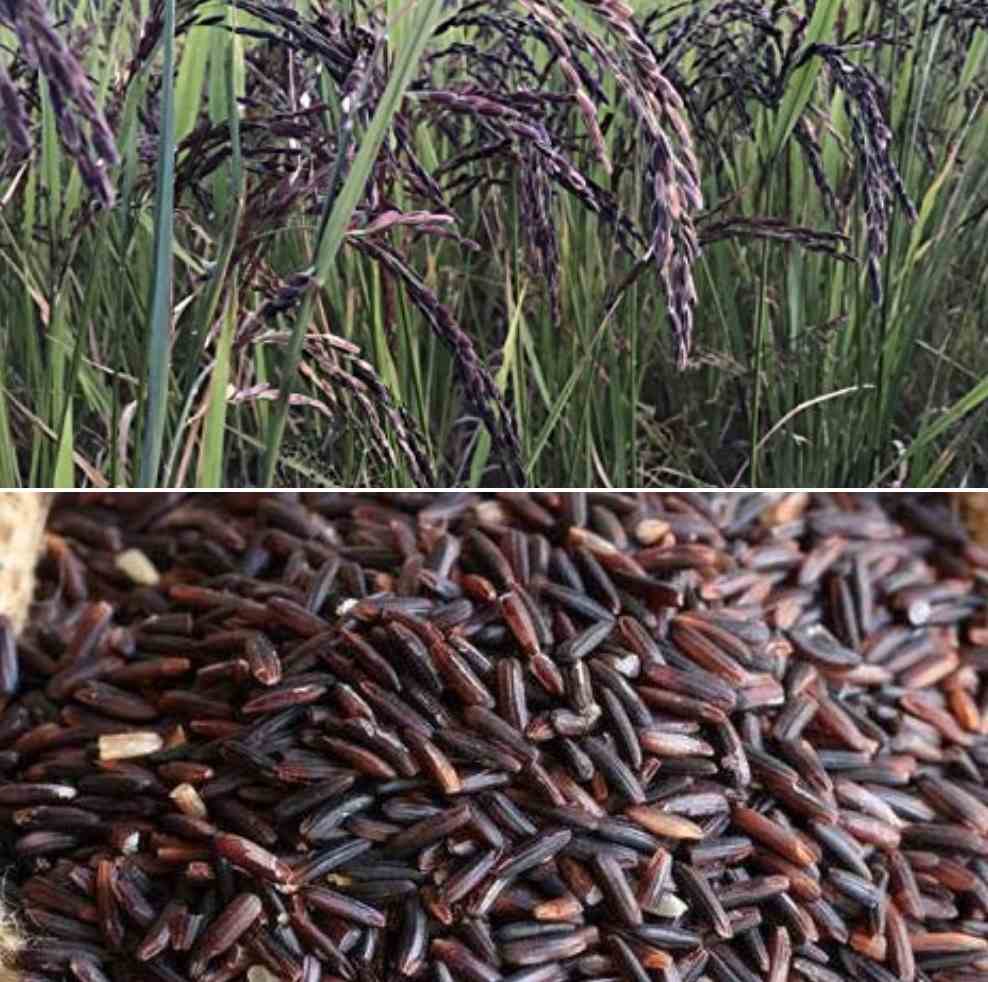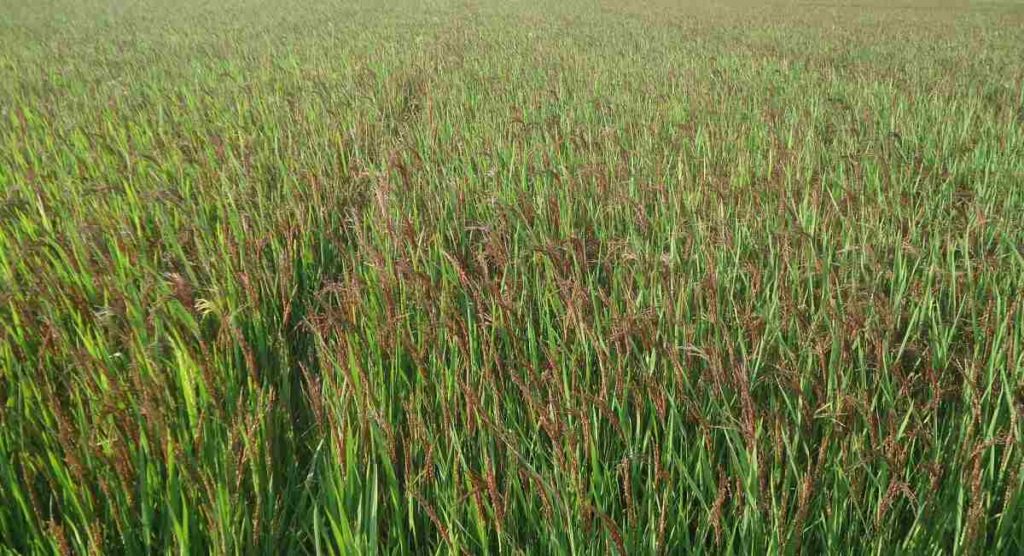Black rice cultivation in India
Black rice is also called forbidden rice, which is a medium-grain, non-glutinous heirloom rice. Black rice has a dark purplish-Black color with a nutty, slightly sweet flavor. Today Black rice is picking up in popularity and popping up in more health food stores. In India, Black rice is cultivated only in few areas especially Manipur- the North Eastern State of India. Now, let us get into the details of the cultivation of Black rice.
A step by steo guide to Black rice cultivation in India
The demand for Black rice has been increasing in today’s world because of their several biological activities due to the presence of antioxidants and phenolic compounds. Phenolics can donate hydrogen and act as decreasing agents. Phenolics also act as singlet oxygen quenchers and free radical hydrogen donors and due to these properties, phenolics have a protective effect on cell constituents against oxidative damage. Such antioxidant characteristics of phenolics have been shown in epidemiological studies to prevent cardiovascular, cancer, and nerve diseases. Other names of Black rice is forbidden rice, emperor’s rice, and purple rice.

Properties of Black rice
The pericarp (outer covering) of Black rice is Black due to the presence of the Black color pigment called anthocyanin which is rich in antioxidants and poses a variety of health benefits such as anti-ageing, anticancer, anti-diabetes, lowering the risk of obesity, etc. Black rice is glutinous and contains a high level of nutrients such as vitamin B, vitamin E, iron, thiamine, magnesium, niacin, phosphorous and it is also rich in dietary fiber. Similar to normal white rice Black rice is also free of gluten and cholesterol, low in sugar, salt, and fat. Black rice is generally consumed along with the bran due to the presence of anthocyanin and is sold as unmilled rice.
Types and varieties of Black rice cultivation
Black Japonica Rice – It is a combination of Black short-grain rice and mahogany medium-grain rice grown together in the same field. It has an earthy flavour with a mild, sweet spiciness.
Black Glutinous Rice – It also known as Black sticky rice is short-grain rice with a sweet flavour and sticky texture. The grains are unevenly coloured and are often used to make sweet dishes in Asia.
Italian Black Rice – It is long-grain rice that combines Chinese Black rice with Italian rice. It has a rich, buttery flavour.
Thai Black Jasmine Rice – It is medium-grain rice from Thailand that combines Chinese Black rice with jasmine rice. It has a subtle floral aroma when cooked.
Morphological and physical characteristics of Black rice
Thousand kernel grain weight (g) – One Thousand grains from each variety were counted and the weight was recorded in grams using an electronic balance.
Bulk density – The volume in ml of 1000 kernel grains was determined by gently pouring the grains into a 100 ml graduated cylinder. The volume occupied by the grains was recorded and the bulk density was calculated as g/ml ratio.
Length breadth ratio – The average length and breadth of the randomly picked 10 grains were measured using a vernier calliper. The length/breadth ratio was obtained by dividing the length of a single grain by the corresponding breadth to determine the size and shape. Based on the L/B ratio the grains were classified as slender (ratio>3), bold (ratio 2-3), and round (ratio <2).
The cost of Black Rice
The cost of Black Rice is approximately Rs 160/ Kilogram
How to germinate Black rice
Black rice is a species of wild rice also called Chinese Black rice. It is medium-grain rice that is high in antioxidants and nutrients. It prefers warm climates and long growing seasons of at least 3 to 6 months. Black rice thrives under full sun and with generous watering. Successful germination requires sustained temperatures of at least 21°C.
Step 1) Fill a container with room temperature water and soak the Black rice seeds for 24 hours. Then, use a sieve to remove any rice seeds that float, as they will not be viable for germination.
Step 2) Strain off the water in the container and secure the lid on top to cover the seeds. Place the container in a sunny, warm location for 24 hours. Temperatures between 21 and 26°C are optimal.
Step 3) Pull any weeds from your planting site and till the soil. Spread one inch of compost on top of the soil, using a rake to make the compost as level as possible.
Step 4) Plant the Black rice seeds just under the surface of the compost, leaving approximately 9 inches between seeds. Lay the seeds flat, rather than with one end pointing upward, as germinated seeds will root more easily from a horizontal position.
Step 5) Water the seeds thoroughly to saturate the soil, and continue watering daily until the seeds sprout, which takes approximately 1 to 2 weeks.
Kalabati Black rice
One local variety of Black rice is “Kalabati” which grows up to 5 to 6.5 feet in height. The duration of Kalabati is 150 days. The medium type of land is suitable for growing of Kalabati. The color of its leaves is a mix of green and purple colors. The number of tillers per plant is a minimum of 20 to 30. The total duration of the crop is 150 days so it can be called as long-duration type rice. After 2 to 3 months of its growth when the plant reaches a height of 2 to 3 feet, it is pruned once during its main vegetative period of growth to encourage more numbers of productive tillers which increases the total yield and productivity per unit area.
The pruned green and purple mix leaves of the Black rice plant are used to feed the milking cows and buffaloes. There is an increase in the amount of production of milk is observed after giving Black rice leaves harvested after 2 to 3 months of crop growth as a highly nutritious (rich in antioxidants and iron) feed to cows and buffaloes.
In case if you miss this: Poultry Feed Chart And Weight Chart.

Rice Panicle is harvested after a period of 5 months starting transplanting from June to July till harvesting the Black rice grains from January to February. Low temperature during the winter season from September up to January is highly necessary to increase the number of productive tillers and total grain yield of Black rice per acre.
The Black rice “Kalabati” (local Variety of Odisha) can only be grown once in a year during the Kharif season, Whereas Manipuri Black rice Chakhao is grown twice as well as thrice in a year due to shorter duration of crop growing period. It is transplanted under SRI (system of rice intensification) or Row transplanting. The traditional way of cultivating Black rice using the broadcasting process can consume 30-40 kg of seeds per acre. The seed rate is 5 kg/acre under SRI as recommended. Seedlings are transplanted by 25cm (row to row) x 25cm (plant to plant) to maintain 64,000 seedlings/acre. Although its yield is comparatively very low (12 to 15 quintal/acre), the price of its seed and rice is sold above 160 Indian rupees per Kilogram in the retail market all over India which is highest among all rice grown in India.
Benefits of Black rice (cultivation)
Weight management – Black rice is associated with a reduction in weight when consumed regularly. This Black rice is unpolished and therefore it is rich in fiber. This will make the person feel full easily. Thus the proportion of food ingestion is reduced. Besides, fiber content also facilitates easy bowel movements. Thus it helps in detoxification.
Anti-diabetic effects – Black rice contains low quantities of sugar and high amounts of fiber which are known to protect the body from diabetes mellitus. Black rice contains essential minerals that help to regulate blood pressure. So, diabetics stand to benefit considerably by including Black rice in their diet.
Reduces allergies – Black rice may help to alleviate the inflammation that occurs in allergies and other illnesses. The bran or outer husk of the rice helps to restrict the release of histamine. Histamine is responsible for the symptoms of allergies. Black rice helps to soothe the irritation and swelling that occurs due to allergic contact dermatitis.
Improves Digestive and Metabolic Health – Black rice contains an impressive amount of fiber per serving. The fiber in Black rice helps prevent constipation, bloating, and other unwanted digestive symptoms. Fiber binds to waste and toxins within the digestive tract, helping pull them out and contribute to regular bowel function. Black rice can also help prevent or improve cases of diarrhea since fiber adds bulk to your stool. The dietary fiber found in Black rice can also importantly help you feel full after eating and stay satisfied for a longer period between meals, potentially aiding in weight loss.
The nutrition profile of Black rice
Black rice calories are not very high. One serving of forbidden or Black rice contains around 160 calories but offers a very high number of flavonoid phytonutrients. It’s also a good source of important fiber, substantial mineral content, and even a good source of plant-based protein. Also, just the outside hull of the grain has one of the highest levels of anthocyanin antioxidants of any food. A 1/4 cup serving of steamed organic Black rice has;
- 156 calories
- 32 grams carbohydrates
- 4 grams of protein
- 1.5 grams of fat
- 2.3 grams of fibre
- 0.7-milligram iron
In case if you are interested in this: How to Make Money from Rice Mill Business.
Sir, I want to buy black rice seed in lucknow, uttar pradesh, can you pls tell me he procedure for farming of black rice.
Hello sir my self Vikram lala in Chattisgarh bilaspur I want black rice seeds … So plz help me how to find seed at my place ..currently
I am an ordinary farmer. I want to cultivate black paddy. If the amount is 1 kg. Let me know how much it will cost. Also tell me how much the delivery charge will be. Please grant me this application.Be careful and stay well.
Could you please provide a complete farming /cultivation guide of black rice and Red rice.
Sir, can someone guide to grow black rice as a sample at my home; later I shall take it up to higher level to grow in a agri field.
I want to grow black rice in distt. Meerut
( western U. P) . Pl. Explain it’s process,
Can you please let me k ow where I can get Manipur Black Rice seeds
Where can i buy these rice whole sale